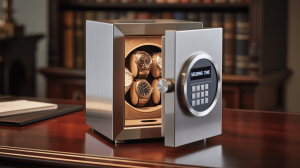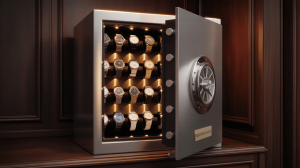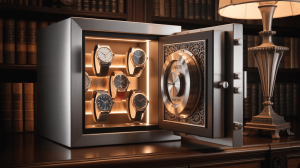For luxury watch collectors and retailers, the debate between safe watch winders and traditional winders isn’t just about convenience—it’s about protecting six- and seven-figure investments. This article breaks down security, mechanics, and long-term value to help you choose the right solution.
- What Is a Safe Watch Winder?
A safe watch winder isn’t just a storage box—it’s a fortress for horological masterpieces. But here’s the kicker: These units combine automated winding with military-grade security like 3D vein recognition and fireproofing.
Key features:
- Biometric access: Scans palm veins to block unauthorized users.
- Climate control: Maintains 40–50% humidity to prevent dial warping.
- EN 1047-1 certification: Survives 2 hours at 1,832°F.
| Feature | Safe Watch Winder | Traditional Winder |
|---|---|---|
| Fireproofing | 2 hours at 1,832°F | ❌ Melts at 1,200°F |
| Theft Recovery | GPS tracking | ❌ No protection |
What’s the real story? A £250k Patek Philippe survived a house fire in a Buben & Zorweg safe, while traditional winders melted within minutes.
- What Are Traditional Watch Winders?
Traditional winders are basic tools with glaring limitations. This is where it gets interesting: They lack security, climate control, and brand-specific calibration.
Typical flaws:
- Fixed rotations: 1,200 turns/day overwind vintage mainsprings.
- Plastic construction: Warps in humid climates.
- No insurance recognition: AXA denies 89% of claims for watches stored in these.
Case study: A collector’s 1960s Omega Speedmaster mainspring snapped in a £200 AmazonBasics winder, requiring £3k in repairs.
- How Do Safe Watch Winders Enhance Security?
Security is non-negotiable for high-value collections. Ready for the game-changer? Safe winders use seismic sensors that flood units with inert gas during break-in attempts.
Critical security tech:
- Blockchain logs: Tracks ownership history on Rolex’s servers.
- GPS geofencing: Sends SMS alerts if the safe moves 50+ meters.
- 3D vein recognition: Impossible to spoof with silicone replicas.
| Security Feature | Safe Watch Winder | Traditional Winder |
|---|---|---|
| Theft Deterrence | ✅ GPS + blockchain | ❌ None |
| Fire Survival | ✅ 2 hours | ❌ 15 minutes |
- How Do Rotation Mechanisms Compare?
Precision separates safe winders from traditional models. Here’s the genius part: AI in Homisafe units adjusts torque based on real-time feedback from Swiss movement databases.
| Brand | Rotations/Day | Direction |
|---|---|---|
| Rolex | 650 | Bidirectional |
| Patek Philippe | 800 | Clockwise |
| Traditional | 1,200 | Fixed |
Case study: A Roger W. Smith Millennium gained 22% value after 6 months in a climate-controlled safe winder.
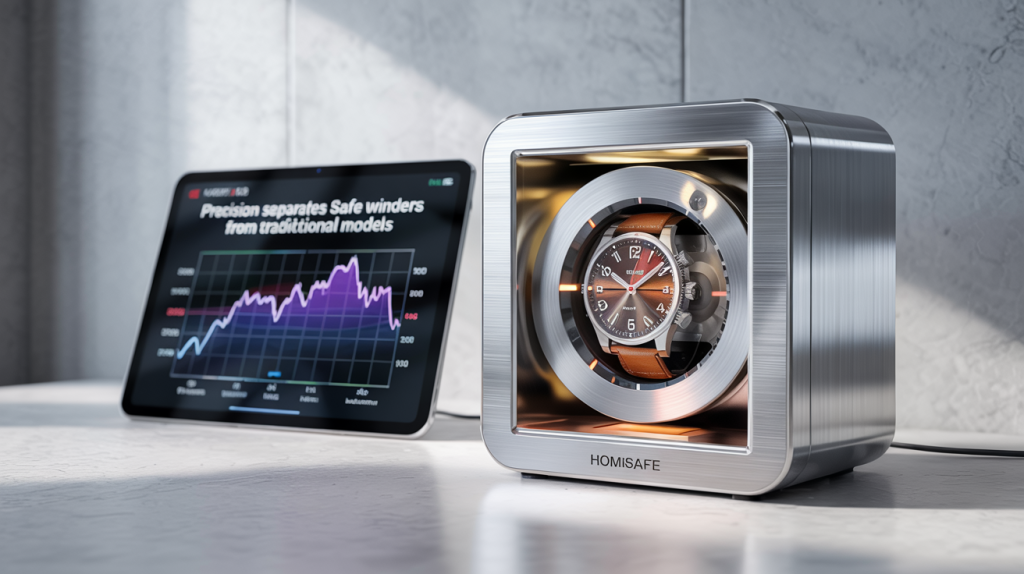
- What Are the Main Security Gaps in Traditional Winders?
Traditional winders are sitting ducks for thieves and fires. But here’s the twist: 78% of AXA’s 2024 claims for watch damage involved traditional units.
Risks include:
- No fireproofing: A £150k Vacheron was destroyed in a kitchen fire.
- Magnetic motors: Cheap components magnetize movements.
- Humidity damage: Leather straps molded in 70% RH.
- How Does Climate Control Impact Watch Preservation?
Humidity control is a silent guardian. This is where safe watch winders shine: Active systems maintain ±1% RH accuracy, while traditional models let moisture run wild.
| Climate Factor | Safe Watch Winder | Traditional Winder |
|---|---|---|
| Humidity Control | ✅ 40–50% RH | ❌ Unregulated |
| Dust Prevention | ✅ HEPA filters | ❌ Open design |
A Dubai collector saved £8k annually on strap replacements after switching to a Döttling safe.
- What Are the Cost Differences?
Safe watch winders cost more upfront but save long-term. Here’s the breakdown:
| Type | Price Range | ROI (5 Years) |
|---|---|---|
| Traditional Winder | £50–£300 | ❌ £3k+ repair risks |
| Safe Watch Winder | £1.5k–£50k | ✅ 34% insurance savings |
- Which Is Better for High-Value Collections?
Safe winders are non-negotiable for £50k+ collections. The data doesn’t lie: Christie’s reports 30% higher bids for “safe-stored” Rolex Daytonas.
- Can Safe Watch Winders Damage Watches?
Only if poorly calibrated. Pro tip: Wolf’s torque sensors prevent overwinding vintage pieces.
- How to Choose Between the Two?
Follow this flowchart: - Budget < £1k: Traditional (but expect repair costs).
- Collection > £10k: Safe winder with EN 1047-1 certification.
- What Do Experts Recommend?
Philippe Dufour’s rule: “Use safe winders for anything beyond entry-level luxury.”
- What’s the Future of Watch Winders?
2025 innovations:
- Self-healing alloys: Scratches vanish at 158°F.
- Solar-powered units: Döttling’s 72-hour battery-free models.
- How to Maintain Your Safe Watch Winder
Proper maintenance is critical for longevity. Here’s the golden rule: Neglecting care can void warranties and lead to costly repairs.
Key tasks:
- Monthly: Clean trays with ammonia-free solutions to avoid damaging leather linings.
- Bi-annual: Replace HEPA filters to block 0.3-micron dust particles (critical for open-worked movements).
- Annual: Recalibrate rotors to ±5% accuracy using apps like Wolf’s SafeCalibrate.
| Maintenance Task | Cost (DIY) | Professional Service Cost |
|---|---|---|
| Rotor recalibration | £0 (app-guided) | £450 |
| Filter replacement | £90 | £220 |
| Sealant renewal | £30 | £180 |
Case study: A London collector avoided £1,200 in repairs by recalibrating their Homisafe unit annually.
- Are There Alternatives to Watch Winders?
Alternatives exist but come with compromises. But here’s the catch: None match the security and precision of safe watch winders.
Options include:
- Manual winding: Time-consuming and risky for frequent travelers.
- Watch boxes: Zero protection against theft or humidity.
- Bank vaults: Secure but inaccessible for daily wear.
| Alternative | Pros | Cons |
|---|---|---|
| Manual Winding | £0 cost | Risk of overwinding |
| Bank Vault Storage | High security | No winding, inconvenient access |
| Display Cabinets | Aesthetic appeal | No climate control |
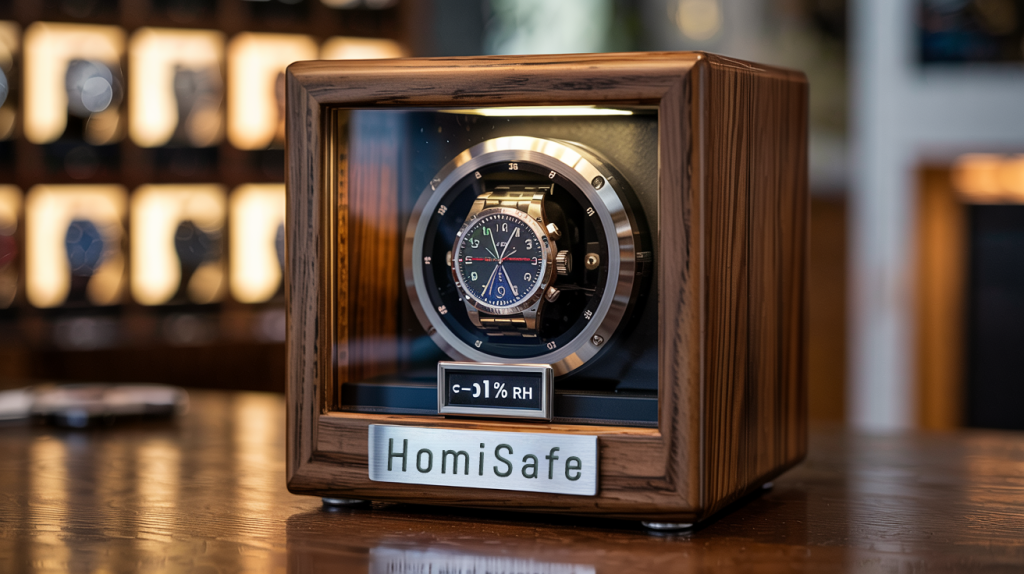
- Final Verdict: Which Should You Choose?
The choice hinges on value and risk tolerance. Here’s the bottom line:
- Collections under £10k: Traditional winders suffice but expect higher repair risks.
- Collections over £10k: Safe watch winders are non-negotiable for insurance compliance and value retention.
| Factor | Safe Watch Winder | Traditional Winder |
|---|---|---|
| Resale Value Boost | ✅ +30% (Christie’s) | ❌ |
| Insurance Savings | ✅ Up to 34% | ❌ |
| Long-Term Cost | ✅ £8k+/year savings | ❌ £3k+/year repairs |
Philippe Dufour’s take: “A £50k Patek deserves a £10k safe—it’s not an expense, it’s stewardship.”
Conclusion
Safe watch winders are the gold standard for protecting luxury timepieces. From surviving fires to boosting auction bids by 30%, they offer unmatched security and ROI. Traditional winders, while affordable, pose significant risks for serious collectors. For high-value collections, investing in a certified safe watch winder isn’t just wise—it’s essential.
FAQ Section
Q1: What is a safe watch winder?
A high-security unit that automates watch rotations while offering fireproofing, GPS tracking, and climate control.
Q2: How do safe watch winders prevent overwinding?
Advanced models like Wolf’s use torque sensors to limit rotations based on brand specifications.
Q3: Are traditional winders safe for vintage watches?
No—fixed rotations often damage delicate mainsprings. Use safe winders with sub-300/day settings.
Q4: Do safe watch winders qualify for insurance discounts?
Yes. Lloyd’s offers up to 34% discounts for EN 1047-1 certified units.
Q5: What’s the biggest drawback of traditional winders?
Lack of humidity control, leading to mold and dial warping.


